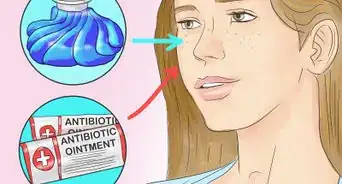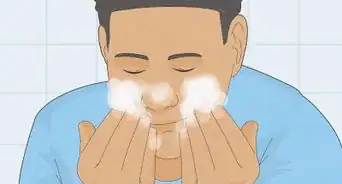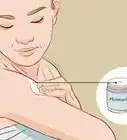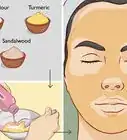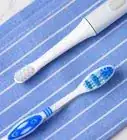This article was co-authored by Mohiba Tareen, MD and by wikiHow staff writer, Megaera Lorenz, PhD. Mohiba Tareen is a board certified Dermatologist and the founder of Tareen Dermatology located in Roseville, Maplewood and Faribault, Minnesota. Dr. Tareen completed medical school at the University of Michigan in Ann Arbor, where she was inducted into the prestigious Alpha Omega Alpha honor society. While a dermatology resident at Columbia University in New York City, she won the Conrad Stritzler award of the New York Dermatologic Society and was published in The New England Journal of Medicine. Dr. Tareen then completed a procedural fellowship which focused on dermatologic surgery, laser, and cosmetic dermatology.
There are 23 references cited in this article, which can be found at the bottom of the page.
This article has been viewed 9,631 times.
If you’re struggling with both oily skin and large pores at the same time, that’s no coincidence! Oil on your skin can clog up your pores and make them look bigger, so taking charge of that excess oil will help reduce your pore size, too.[1] Things like acne, sun damage, and sagging skin can also play a role making your pores look big, so give your skin the TLC it needs to keep these issues under control.
Steps
Managing Excess Oil
-
1Wash your face twice a day and whenever you sweat. Cleanse your face in the morning and evening to get rid of excess oils and dirt and keep your pores clear. You produce more oil when you exercise and break a sweat, so wash up after exercising, doing hard physical work, or being out in the heat, too.[2]
- As annoying as it might be, it’s totally normal—and even healthy—for your skin to produce oil throughout the day. The goal of washing your skin is to keep too much oil from building up, rather than to totally get rid of it.
-
2Use a gentle, oil-free foaming face wash and warm water. When you wash up, stick to mild, water-based cleansers that are formulated for your oily skin type. The last thing you want is to clog your pores up with even more oil! Look for a cleanser that’s marked “non-comedogenic” (meaning it won’t clog your pores) or “oil-free.”[3]
- Avoid cleansers that contain alcohol or other harsh, drying ingredients, like dyes and perfumes. You don’t want to over-dry your face, either, since this will just signal your skin to pump out even more oil.
- Always be gentle with your skin when you wash it. Use warm water (not hot) and gently rub the cleanser on with your fingertips.[4]
Advertisement -
3Apply an oil-free moisturizer after washing your face. If your skin is already super oily, you might think that you don’t need moisturizer. But washing your face can dry out your skin and stimulate even more oil production, so moisturizing should be a regular part of your skincare routine. Any time you wash up, follow up with a gentle, oil-free moisturizer.[5]
- Look for moisturizers that are designed for oily skin. The label may say “oil-free,” “non-comedogenic,” or “won’t clog pores.”
- For the added bonus of protection from sun damage, choose a moisturizer that contains sunscreen with an SPF of at least 30.
- Moisturizers containing hyaluronic acid as an active ingredient may be especially helpful for keeping your skin healthy and hydrated. This acid occurs naturally in the human body and helps promote healing and tissue regeneration.[6]
-
4Choose water-based, oil-free makeup and other cosmetics. If you wear makeup, look for gentle products that are designed for oily or acne-prone skin. That way, you won’t end up with even more oil clogging up your pores.[7]
- Always clean your face thoroughly to remove any makeup at the end of the day, even if the makeup is oil-free. Never go to sleep with makeup on your face.[8]
- Steer clear of long-wear or waterproof cosmetics, since they can be especially hard on your skin. Long-wearing formulas are often drying, and waterproof makeup is heavy and difficult to remove without harsh or oily cleansers.
-
5Blot your face with oil-absorbing papers throughout the day. Before you head out for the day, make sure you have some oil-blotting papers in your bag, purse, or pocket. Break them out any time your face starts developing an oily shine. Gently pat the paper over your face to soak up excess oil.[9]
- Remember—pat, don’t rub. Rubbing the paper around will just smear the oil all over your face!
-
6Avoid touching your face so you don’t introduce dirt, germs, and oils. This is a tough one, but do your best to keep your hands off of your face. Your hands pick up all kinds of dirt and gunk throughout the day, and when you touch your face, it can get into your pores.[10]
- If you need to scratch your face, try using your arm or shoulder instead of your hand.[11]
- If you tend to fidget with your face a lot, try using a stress ball, a fidget spinner, or some other small object to keep your hands busy.
- Of course, you have to touch your face sometimes! Just make sure to wash your hands with soap and water first.
-
7Ask your doctor about oral medications for severely oily skin. If your skin is extremely oily and other treatments aren’t doing the trick, there are medications that can help. Make an appointment with your doctor or a dermatologist to discuss your options. Some possible treatments include:[12]
- Isotretinoin (Accutane). This super-effective acne medication works by shrinking your sebaceous glands and seriously scaling back how much oil they produce. Unfortunately, it also comes with the risk of unpleasant side effects, like severely dry skin and eyes. Don’t take it if you’re pregnant or planning to get pregnant.
- Spironolactone. This medication is normally used to treat high blood pressure, but it can also help clear up oily skin. It’s a lot less likely to cause side effects than isotretinoin, but still discuss the risks with your doctor.
- Hormonal birth control pills. “The pill” does more than just prevent pregnancy—it can also help get oily skin and acne under control. It’s not risk-free, though, so talk to your doctor about possible side-effects before you use it.
-
8Talk to your doctor about Botox injections if other treatments don’t work. You might think of Botox (botulinum toxin) primarily as a treatment for lines and wrinkles, but it’s also great for minimizing oiliness and enlarged pores.[13] If you’re struggling to keep your oily skin under control, ask your doctor or a dermatologist if Botox injections might help.
- The treatment can last for a few weeks or even months, but it’s not permanent. You’ll need to go back for more injections occasionally, depending on how your skin reacts or what your dermatologist recommends.
- In general, Botox injections are pretty safe, but there are some possible risks and side effects. The most common side effects include bruising or pain around the injection site, headaches, flu-like symptoms, or drooping of the eyelids or mouth.[14]
- Always get a referral from your doctor or dermatologist for Botox treatments. They can recommend a reputable, experienced doctor who can give you the treatment safely.
Minimizing Your Pores
-
1Exfoliate your skin to keep your pores clean. When dirt, oil, and dead skin cells build up in your pores, it can make them look bigger. When you wash your face, use a soft washcloth or a mild exfoliating scrub and take about 30 seconds to very lightly buff away any crud that may have accumulated on your skin and in your pores.[15]
- Be gentle and avoid scrubbing hard when you exfoliate. Just use your fingertips or make very short, light strokes with a sponge or soft cloth.
- Some skincare experts recommend exfoliating as often as once a day.[16] Others say to do it less often—like only 2-3 times a week. If you’re not sure how often to exfoliate, get advice from a dermatologist.
- If your skin is very oily, you might benefit from a more powerful chemical exfoliant. Look for exfoliating cleansers with ingredients like alpha hydroxy acids (AHAs, such as lactic acid or glycolic acid) or beta hydroxy acids (BHAs, such as salicylic acid).[17]
- If your skin is red, inflamed, or irritated, avoid exfoliating for now. These are signs of over-exfoliation. You'll want to soothe your skin and restore its natural barrier first before you start exfoliating again.[18]
-
2Wear sunscreen to prevent sagging and skin damage. Too much exposure to the sun will damage your skin over time and age it prematurely, leading to sagging and wrinkles.[19] When your skin sags, your pores look bigger. Protect yourself by slathering on an oil-free, broad-spectrum sunscreen with an SPF of at least 30 whenever you spend time outdoors.[20] Reapply your sunscreen every 2 hours, or more often if you’re wet or sweaty.[21]
- Don’t skip the sunscreen just because it’s cold or cloudy out! You may not be able to see or feel the sun as much, but it can still do damage.
- Give yourself extra protection by putting on a hat, some shades, and clothing that covers most of your skin.
-
3Try products with retinoids to gently firm your skin. Retinol, retinyl palmitate, and other forms of vitamin A are great for your skin. Retinoids actually reduce sebum (oil) production.[22] Not only can they subtly tighten your skin, but they also break down oils and other contaminants that can irritate your pores. Smooth a cream with one of these ingredients onto your skin every night before bed, and you may notice a difference in the appearance of your pores.[23]
- If you notice any stinging or irritation when you put on a retinoid cream, wait 30 minutes after washing your face before you put it on.
- Don’t use any retinoid products if you’re pregnant or breastfeeding unless your doctor says it’s okay.
-
4Ask your doctor about treatments to firm sagging skin. Unfortunately, it’s natural for your skin to start sagging more as you get older. That can make your pores look a little bigger.[24] While you can’t totally avoid the sag, you can try procedures that subtly tighten up your skin, such as ultrasound treatments, radiofrequency treatments, or laser treatments.[25]
- These non-surgical treatments involve sending heat under your skin to encourage the production of new collagen. After a treatment, your skin will gradually tighten over the next few months.
- Injectable fillers can also temporarily plump up your skin and reduce the appearance of imperfections, such as fine lines, scars, hollows, and enlarged pores.[26] Hyaluronic acid fillers may be particularly useful for minimizing pores.[27]
- For your safety, always see a dermatologist or an experienced cosmetic physician for these types of treatments.[28]
Treating Acne and Clogged Pores
-
1Dissolve pore-clogging oils with salicylic acid. Pimples form when your pores or hair follicles get clogged up with oil and dead skin.[29] All that gunk can inflame your pores and make them look bigger, so treating your acne can improve your pore situation, too. If your skin is both oily and acne-prone, wash your face at least once a day with a salicylic acid-based cleanser to break down the oils and other junk in your pores.[30]
- Salicylic acid is a BHA (beta hydroxy acid). BHAs are oil-soluble, which means they’re especially good at cleaning acne-causing oils out of your pores and follicles![31]
- If you find salicylic acid cleansers drying, alternate between a gentle, water-based cleanser in the morning and a mild salicylic acid cleanser in the evening. Always put on an oil-free moisturizer when you’re done.
-
2Kill acne-causing bacteria with benzoyl peroxide.[32] Oils and dead skin aren’t the only culprits behind acne. Bacteria on your skin can also lead to pimples and inflamed pores. Smooth on a benzoyl peroxide gel or topical cream, or use a cleanser with benzoyl peroxide to wash your face. This will help kill off those irritating germs on your skin.[33]
- Benzoyl peroxide can dry out or irritate your skin, so start with a gentle, low-concentration formula and see if that works for you.
- Follow the directions on the package or ask your doctor for advice about how often to apply a benzoyl peroxide product.
- If you have severe acne, your doctor might prescribe a medication that combines benzoyl peroxide with another topical antibiotic, such as clindamycin.[34]
-
3Apply a retinoid acne cream to break up clogs and prevent new pimples. Retinoids, or topical vitamin A treatments, are good for more than just firming up your skin. They also help clean out oils, dead skin, and other junk that can clog your pores and lead to pimples. If you’re prone to acne, ask your doctor about trying a prescription or over-the-counter retinoid acne treatment.[35]
- Some common retinoid acne treatments include Retin-A, Tazorac, and Differin. Differin is available over the counter, but you’ll need a prescription for Retin-A or Tazorac.
- Your doctor may recommend avoiding these medications if you’re pregnant or breastfeeding.
- Retinoids can dry out or irritate your skin, but these side effects usually get better with time. You can also minimize irritation by using a gentle, oil-free moisturizer.
-
4Avoid squeezing or picking at pimples or blackheads. Picking at your face or squeezing pimples can inflame your pores and make them look bigger, so resist the temptation to mess with any pesky zits.[36] If you absolutely have to get rid of a pimple and home treatments aren’t working, see your doctor to have it extracted professionally.[37]
- Sometimes, you can coax a pimple pop on its own by putting a hot, wet washcloth on it once a whitehead forms. Do this for 10-15 minutes at a time, 3-4 times a day until your pimple heals up.[38]
-
5Ask your doctor before using combinations of acne treatments. Many acne treatments work best when you use them in combination. However, there’s some risk that if you combine multiple medications, you might damage or irritate your skin. Before you start mixing and matching acne meds, ask your doctor or pharmacist for advice.[39]
- For example, combining retinoids and benzoyl peroxide can irritate your skin. However, you may be able to use them together safely by alternating between the 2 treatments every other day.
Expert Q&A
Did you know you can get expert answers for this article?
Unlock expert answers by supporting wikiHow
-
QuestionWhat causes large pores?
 Mohiba Tareen, MDMohiba Tareen is a board certified Dermatologist and the founder of Tareen Dermatology located in Roseville, Maplewood and Faribault, Minnesota. Dr. Tareen completed medical school at the University of Michigan in Ann Arbor, where she was inducted into the prestigious Alpha Omega Alpha honor society. While a dermatology resident at Columbia University in New York City, she won the Conrad Stritzler award of the New York Dermatologic Society and was published in The New England Journal of Medicine. Dr. Tareen then completed a procedural fellowship which focused on dermatologic surgery, laser, and cosmetic dermatology.
Mohiba Tareen, MDMohiba Tareen is a board certified Dermatologist and the founder of Tareen Dermatology located in Roseville, Maplewood and Faribault, Minnesota. Dr. Tareen completed medical school at the University of Michigan in Ann Arbor, where she was inducted into the prestigious Alpha Omega Alpha honor society. While a dermatology resident at Columbia University in New York City, she won the Conrad Stritzler award of the New York Dermatologic Society and was published in The New England Journal of Medicine. Dr. Tareen then completed a procedural fellowship which focused on dermatologic surgery, laser, and cosmetic dermatology.
FAAD Board Certified Dermatologist Pores are actually the openings of the tiny hairs that we have covering all of our skin. Unfortunately, pore size is genetically determined by a) the openings of the hair follicles and b) the number of hairs you have. The two biggest culprits of pores looking larger than they really are are excessive oil production leading to congestion and dilation of the pore and also the loss of elasticity of the skin as we age.
Pores are actually the openings of the tiny hairs that we have covering all of our skin. Unfortunately, pore size is genetically determined by a) the openings of the hair follicles and b) the number of hairs you have. The two biggest culprits of pores looking larger than they really are are excessive oil production leading to congestion and dilation of the pore and also the loss of elasticity of the skin as we age. -
QuestionWhat kills bacteria on your face?
 Mohiba Tareen, MDMohiba Tareen is a board certified Dermatologist and the founder of Tareen Dermatology located in Roseville, Maplewood and Faribault, Minnesota. Dr. Tareen completed medical school at the University of Michigan in Ann Arbor, where she was inducted into the prestigious Alpha Omega Alpha honor society. While a dermatology resident at Columbia University in New York City, she won the Conrad Stritzler award of the New York Dermatologic Society and was published in The New England Journal of Medicine. Dr. Tareen then completed a procedural fellowship which focused on dermatologic surgery, laser, and cosmetic dermatology.
Mohiba Tareen, MDMohiba Tareen is a board certified Dermatologist and the founder of Tareen Dermatology located in Roseville, Maplewood and Faribault, Minnesota. Dr. Tareen completed medical school at the University of Michigan in Ann Arbor, where she was inducted into the prestigious Alpha Omega Alpha honor society. While a dermatology resident at Columbia University in New York City, she won the Conrad Stritzler award of the New York Dermatologic Society and was published in The New England Journal of Medicine. Dr. Tareen then completed a procedural fellowship which focused on dermatologic surgery, laser, and cosmetic dermatology.
FAAD Board Certified Dermatologist
-
QuestionHow can I make my face skin tighter?
 Mohiba Tareen, MDMohiba Tareen is a board certified Dermatologist and the founder of Tareen Dermatology located in Roseville, Maplewood and Faribault, Minnesota. Dr. Tareen completed medical school at the University of Michigan in Ann Arbor, where she was inducted into the prestigious Alpha Omega Alpha honor society. While a dermatology resident at Columbia University in New York City, she won the Conrad Stritzler award of the New York Dermatologic Society and was published in The New England Journal of Medicine. Dr. Tareen then completed a procedural fellowship which focused on dermatologic surgery, laser, and cosmetic dermatology.
Mohiba Tareen, MDMohiba Tareen is a board certified Dermatologist and the founder of Tareen Dermatology located in Roseville, Maplewood and Faribault, Minnesota. Dr. Tareen completed medical school at the University of Michigan in Ann Arbor, where she was inducted into the prestigious Alpha Omega Alpha honor society. While a dermatology resident at Columbia University in New York City, she won the Conrad Stritzler award of the New York Dermatologic Society and was published in The New England Journal of Medicine. Dr. Tareen then completed a procedural fellowship which focused on dermatologic surgery, laser, and cosmetic dermatology.
FAAD Board Certified Dermatologist
References
- ↑ https://www.aad.org/public/everyday-care/skin-care-secrets/face/treat-large-pores
- ↑ https://www.aad.org/news/how-to-control-oily-skin
- ↑ https://www.aad.org/news/how-to-control-oily-skin
- ↑ https://www.aad.org/public/everyday-care/skin-care-basics/care/face-washing-101
- ↑ https://www.aad.org/news/how-to-control-oily-skin
- ↑ https://www.ncbi.nlm.nih.gov/pmc/articles/PMC3583886/
- ↑ https://www.aad.org/public/everyday-care/skin-care-secrets/face/treat-large-pores
- ↑ https://www.aad.org/news/how-to-control-oily-skin
- ↑ https://www.aad.org/news/how-to-control-oily-skin
- ↑ https://www.aad.org/news/how-to-control-oily-skin
- ↑ https://www.bbc.com/future/article/20200317-how-to-stop-touching-your-face
- ↑ https://www.ncbi.nlm.nih.gov/pmc/articles/PMC5605215/
- ↑ https://www.ncbi.nlm.nih.gov/pmc/articles/PMC5605215/
- ↑ https://www.mayoclinic.org/tests-procedures/botox/about/pac-20384658
- ↑ https://www.aad.org/public/everyday-care/skin-care-secrets/face/treat-large-pores
- ↑ https://health.clevelandclinic.org/5-ways-to-exfoliate-your-skin-without-irritation/
- ↑ https://health.clevelandclinic.org/5-ways-to-exfoliate-your-skin-without-irritation/
- ↑ Mohiba Tareen, MD. Board Certified Dermatologist. Expert Interview. 26 March 2020.
- ↑ Mohiba Tareen, MD. Board Certified Dermatologist. Expert Interview. 26 March 2020.
- ↑ https://www.aad.org/public/everyday-care/skin-care-secrets/face/treat-large-pores
- ↑ https://www.skincancer.org/skin-cancer-prevention/sun-protection/sunscreen/
- ↑ Mohiba Tareen, MD. Board Certified Dermatologist. Expert Interview. 26 March 2020.
- ↑ https://www.aad.org/public/everyday-care/skin-care-secrets/face/treat-large-pores
- ↑ https://www.aad.org/public/everyday-care/skin-care-secrets/face/treat-large-pores
- ↑ https://www.aad.org/public/cosmetic/younger-looking/firm-sagging-skin
- ↑ https://www.aad.org/public/cosmetic/wrinkles/fillers-overview
- ↑ https://pubmed.ncbi.nlm.nih.gov/28786543/
- ↑ https://www.aad.org/public/cosmetic/wrinkles/fillers-faqs
- ↑ https://www.mayoclinic.org/diseases-conditions/acne/symptoms-causes/syc-20368047
- ↑ https://www.aad.org/public/everyday-care/skin-care-secrets/face/treat-large-pores
- ↑ https://www.ncbi.nlm.nih.gov/pmc/articles/PMC4554394/
- ↑ Mohiba Tareen, MD. Board Certified Dermatologist. Expert Interview. 26 March 2020.
- ↑ https://my.clevelandclinic.org/health/diseases/12233-acne/management-and-treatment
- ↑ https://www.mayoclinic.org/diseases-conditions/acne/diagnosis-treatment/drc-20368048
- ↑ https://my.clevelandclinic.org/health/diseases/12233-acne/management-and-treatment
- ↑ https://www.aad.org/public/everyday-care/skin-care-secrets/face/treat-large-pores
- ↑ https://www.mayoclinic.org/diseases-conditions/acne/diagnosis-treatment/drc-20368048
- ↑ https://youtu.be/9guuwHcpG-U?t=27
- ↑ https://www.aafp.org/afp/2000/0115/p357.html
- ↑ https://www.aarp.org/entertainment/style-trends/info-2016/makeup-tips-young-face.html
- ↑ https://www.ncbi.nlm.nih.gov/pmc/articles/PMC5605215/
- ↑ https://www.zora.uzh.ch/id/eprint/66594/1/Meier_et_al_Jojoba_Oil_FOKOM_19%282%29_2012_75-79.pdf
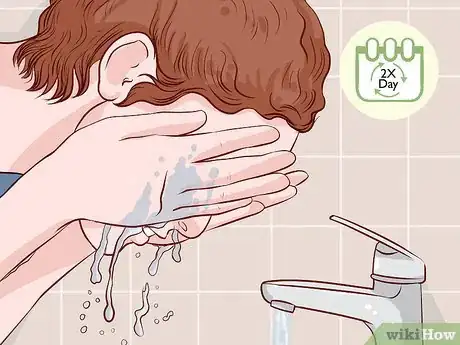
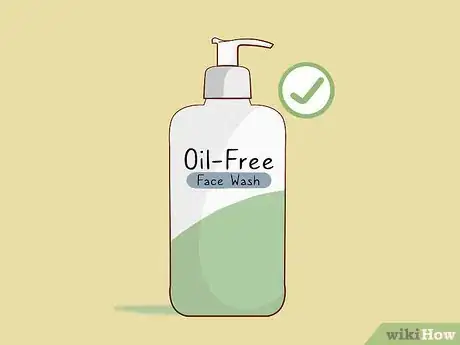
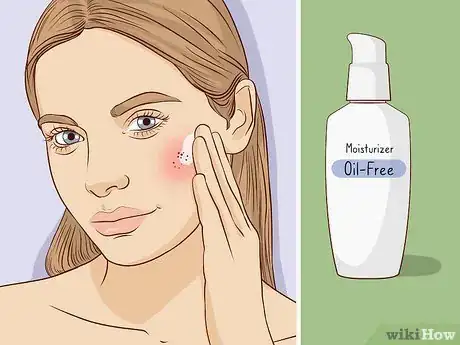
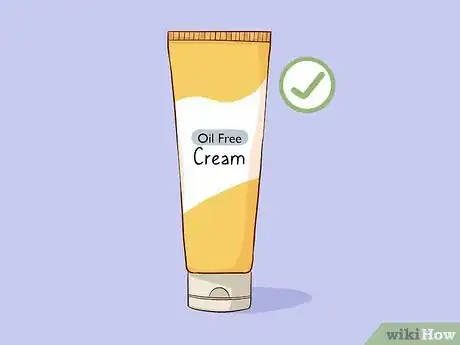
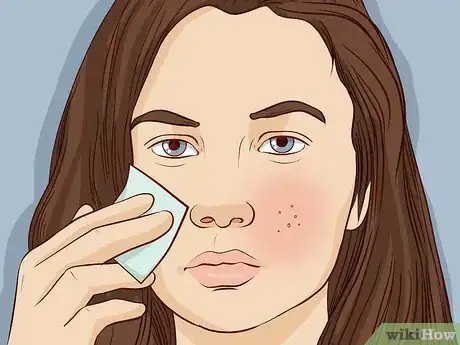
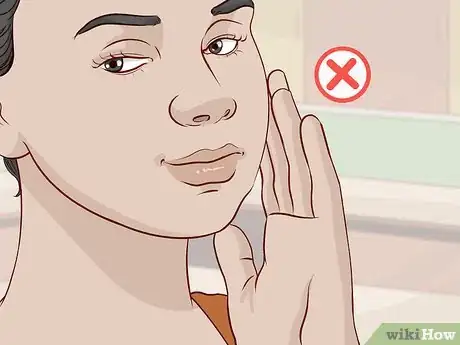
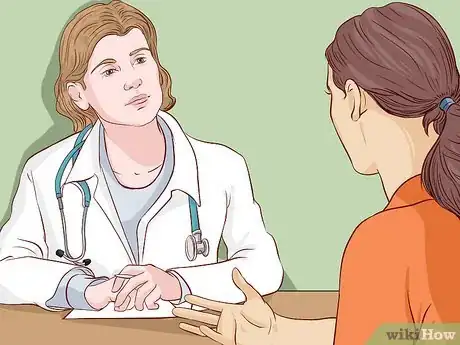
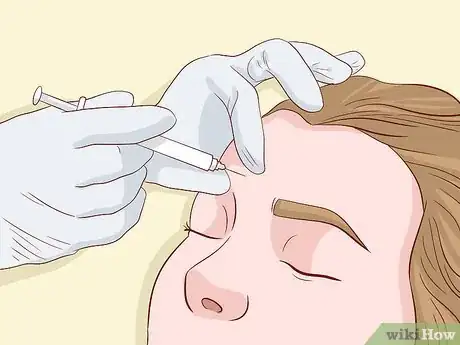
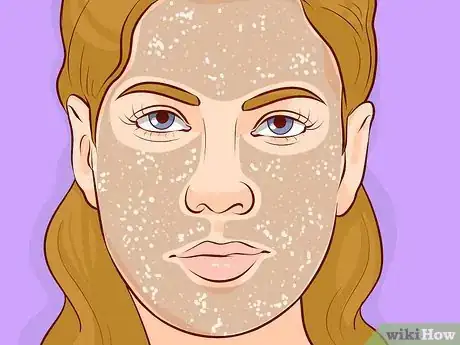

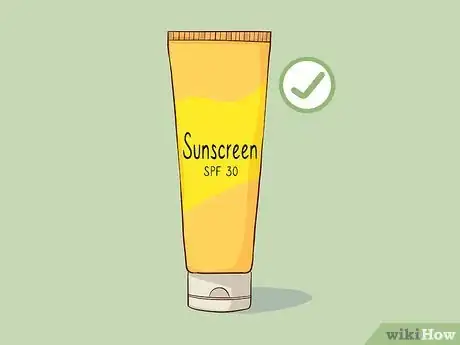
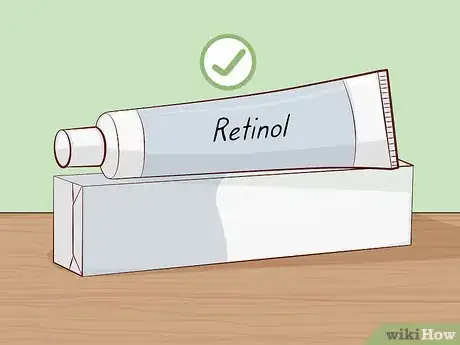
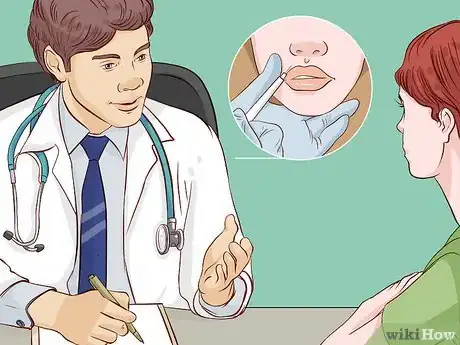
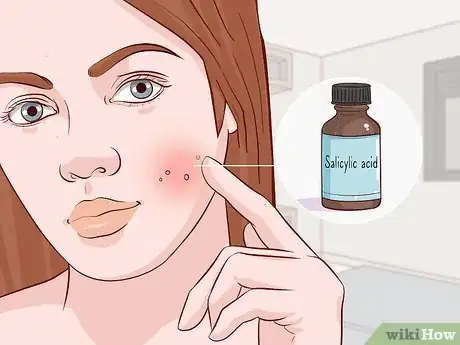
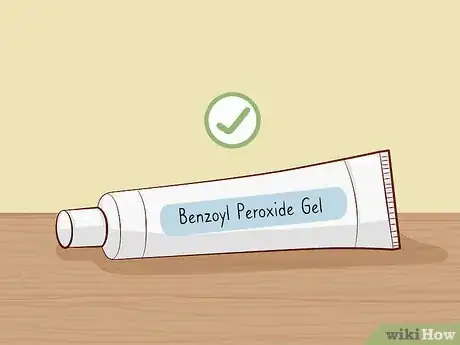
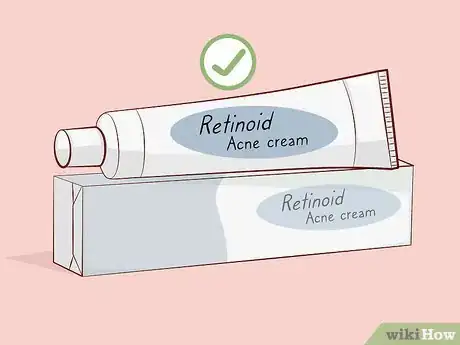
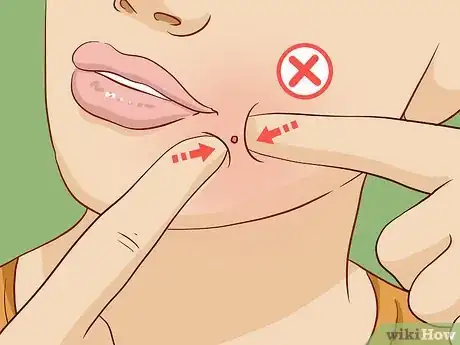
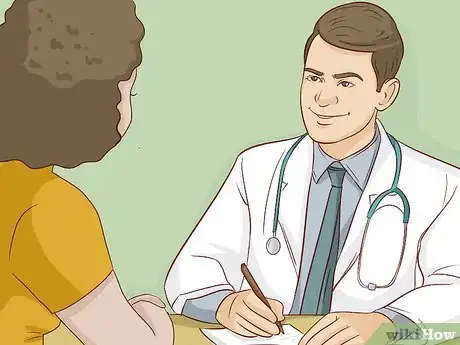

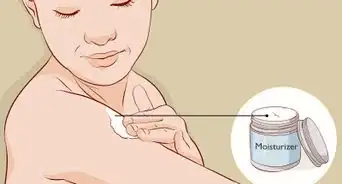
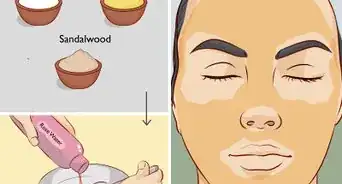
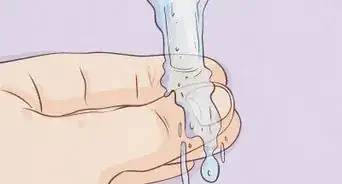
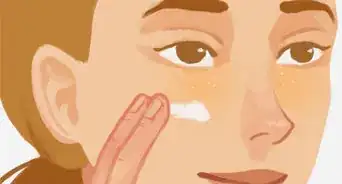
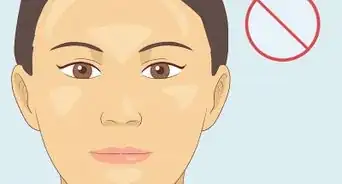
-Step-12-Version-3.webp)

